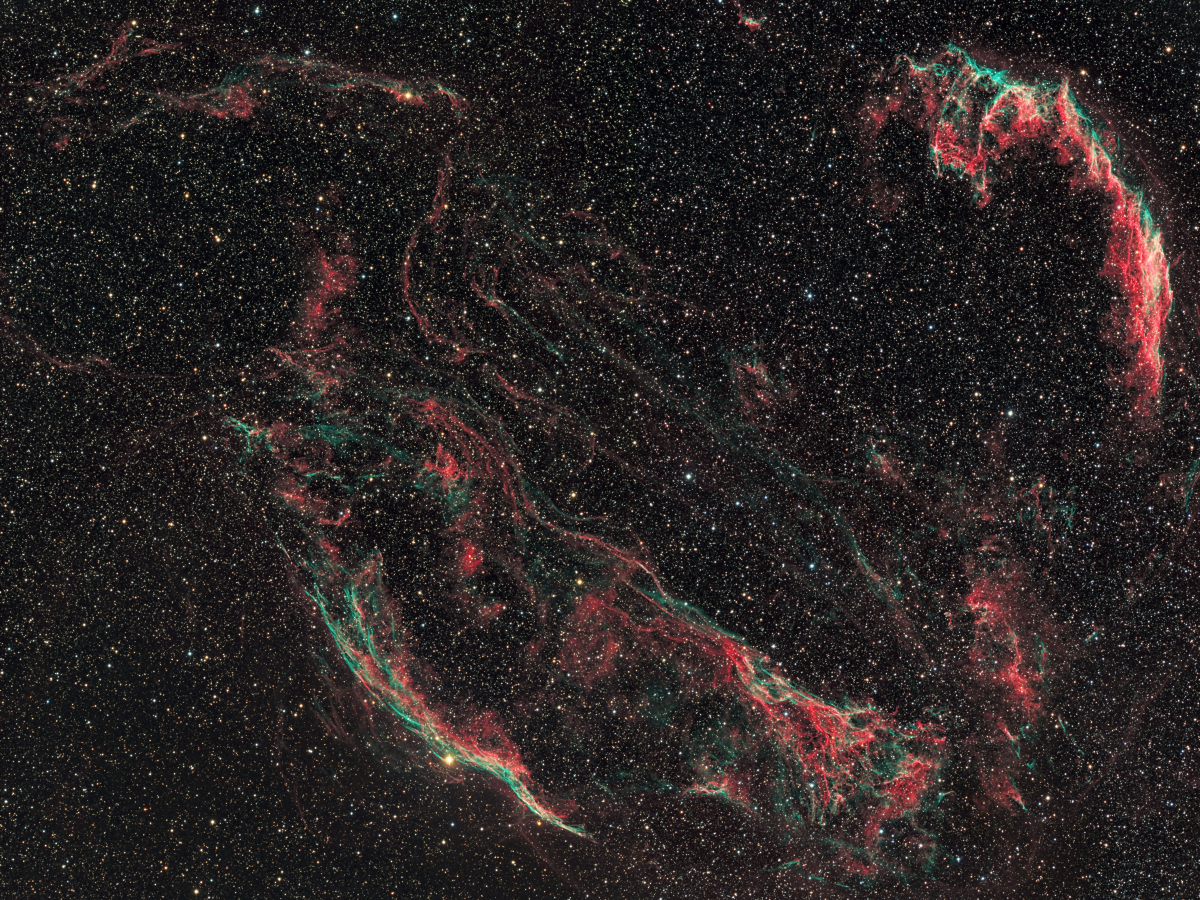
Sharpless 103 / Cygnus Loop / Veil Nebula
Supernova Remnant in Cygnus
RA: 20h 45m 38s; Dec: 30° 42′ 30″; Dist: ~1470 ly


| Exposure | ||||||
| This is a 4 panel mosaic captured over the summer and fall of 2015 and 2016. | ||||||
| Total Image Frames | 1632 | |||||
| Total Image Time | 96 hours | |||||
| Per Panel | Total | |||||
| Filter | Frames | Exposure | Frames | Elapsed Time | Start Date | End Date |
| Lum | 180 | 120 sec | 720 | 24h | 10-Jul-2015 | 01-Oct-2016 |
| Red | 60 | 120 sec | 240 | 8h | 17-Jul-2015 | 01-Oct-2016 |
| Green | 60 | 120 sec | 240 | 8h | 17-Jul-2015 | 01-Oct-2016 |
| Blue | 60 | 120 sec | 240 | 8h | 05-Aug-2015 | 30-Sep-2016 |
| Hα | 24 | 900 sec | 96 | 24h | 22-Jul-2015 | 01-Oct-2016 |
| Oiii | 24 | 900 sec | 96 | 24h | 22-Jul-2015 | 01-Oct-2016 |
| Imaging Locations | Ft McKavett TX | |||||
| General Nathan Twining Observatory NM | ||||||
| Kenton OK - Okie-Tex Star Party | ||||||
| Magdalena NM | ||||||
| San Ysidro NM - White Ridge bicycle trails parking lot | ||||||
| Tijeras NM | ||||||
| Hardware | |
| Imaging Instrument | 4 Inch Refractor at Prime Focus |
| Focal Length | 530 mm |
| Focal Ratio | 5.0 |
| Imaging Camera | QSI 683ws-g |
| Guiding Instrument | OAG via QSI IGP |
| Guiding Camera | Starlight Xpress Lodestar X2 |
| Software | |
| Image Capture | Sequence Generator Pro |
| Guiding | PHD v2 |
| Image Processing | PixInsight |
| Other Image Sizes | |
| Full Resolution Image - email me | |
| Half Resolution Image (6000x4500) | |
| Large Image (3000x2250) | |
| Medium Image (1200x900) | |
| Small Image (600x450) | |
| Imaging Notes |
| The nebula colors should be pretty close to correct. I found LEDs emitting at 502nm (Oiii is 500.7) and 657nm (Ha is 656.3) to use as color references during processing. My monitor is calibrated and I converted the images ICC profiles to sRGB for compatability with the common browsers. |
| I use Sequence Generator Pro for image capture. It makes collecting mosaic frames easy--automatically shifting between the mosaic panels and doing plate solves to put the camera back on the exact pixel and rotation night-after-night and location-after-location. I had 20 location changes during the year and a half of exposure capture. |
| Though the exposure information shows 1632 sub-frames over 96 hours, I really captured 2296 sub-frames accounting for 132 hours total exposure. I then chose the best 6 hours of luminance, Hα, and Oiii and the best 2 hours of red, green, and blue for each panel to make build the image. |
| The image is rotated 120° clockwise to fit the object mosaic and because I think it looks pretty good that way. |